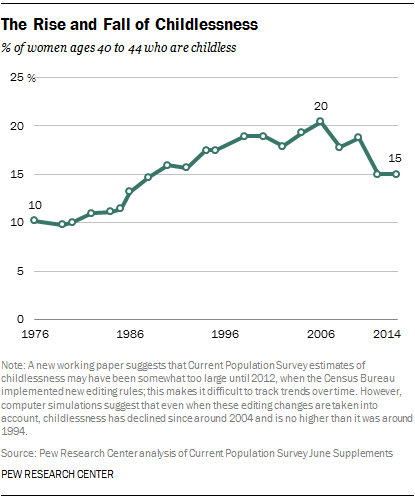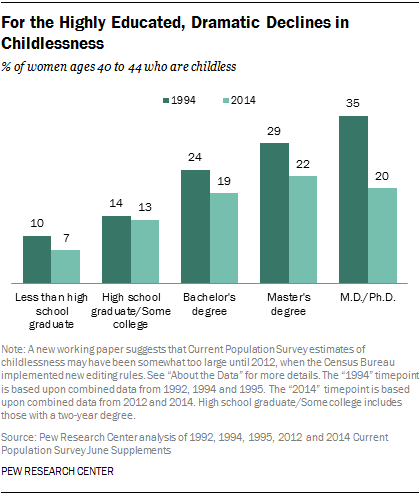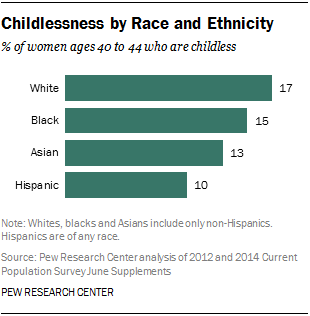
In the mid-1970s, when data on lifetime childlessness first became available, one-in-ten U.S. women ages 40 to 44 had never had a biological child. Childlessness remained quite low into the 1980s, and rose precipitously thereafter.
While the likelihood of remaining childless has been on the decline recently among women at the end of their childbearing years, childlessness has been consistently rising among younger women since the 1970s, when data first became available. Delays in childbearing related to increasing educational attainment and women’s labor force participation explain much of this long-term trend, though the recent economic downturn has been associated with a particularly sharp downturn in fertility among the young.
Educational Differences in Childlessness

For the most part, more education is associated with higher rates of childlessness for women ages 40 to 44. While just 7% of women who lack a high school diploma are childless, this share about doubles, to 13%, for those who graduated from high school or have some college experience. Among women with a bachelor’s degree or more, about one-in-five are childless – 19% for those with a bachelor’s degree only; 22% for those with a master’s degree; and 20% for those with an M.D. or Ph.D.
While the educational differences in childlessness persist, the gap has narrowed significantly since the mid-1990s. Across all educational groups, childlessness has either remained constant or declined in the past two decades, with the biggest declines occurring among more educated women. In 1994, fully 35% of women ages 40 to 44 with an M.D. or Ph.D. were childless, but by 2014, this number had dropped to 20%. Childlessness dropped by 7 percentage points among women with a master’s degree, and by 5 percentage points for those with a bachelor’s degree. Changes in childlessness have been smaller for those with less education. Among women who did not finish high school, childlessness dropped by 3 percentage points, and for those who have a high school diploma, rates of childlessness are essentially unchanged from 20 years ago.
Declining childlessness among highly educated women is driven in part by the changing composition of these women. While at one time obtaining an advanced degree was something that few did, it is becoming more common. On a related note, the share of highly educated women who marry—and who are thus more likely to have children—has also increased. Furthermore, advances in reproductive technology, which allow women to delay childbearing, have likely played a role in the increasing share of highly educated women who become mothers, many of whom wait until older ages to do so.
Racial and Ethnic Differences in Childlessness

The prevalence of childlessness varies by race and ethnicity as well. Hispanic women are far less likely to remain childless throughout their childbearing years than are non-Hispanic whites or blacks. Just 10% of Hispanic women ages 40 to 44 now report having had no biological children. At the other end of the spectrum, fully 17% of white women in this age range report the same. Some 15% of black women are childless, as are 13% of Asian women.
Across major racial and ethnic groups, childlessness today appears to vary no more than a few percentage points from what it was in 1994, or even 1988, the first year for which detailed fertility data are available. In the late 1980s, 15% of white women ages 40 to 44 were childless, as were 14% of black women and 11% of Hispanic women. Fertility data on Asian women are not available for 1988, but in 1994, some 14% of these women were childless.1




